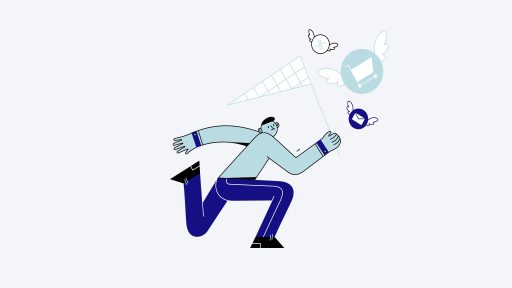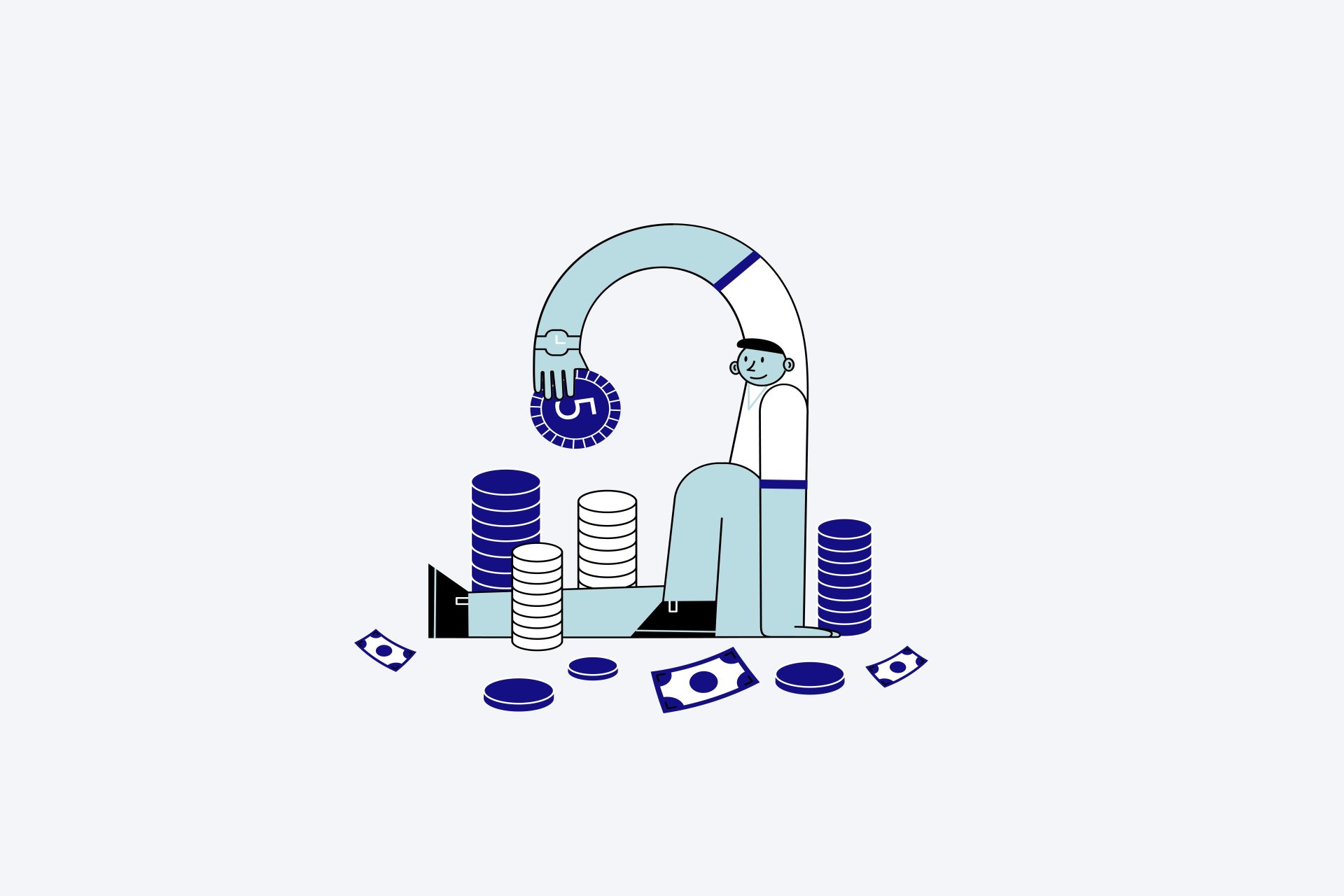Uncover impactful tactics to elevate your Shopify store through blogging. Acquire knowledge on captivating your audience, enhancing SEO, and increasing sales with our expert guidance.

Engage in the D2C Insider
Keen on obtaining regular updates and inspiration to keep your business ahead in the competition?
Generating traffic is the guiding star for all online business proprietors. You cannot convert without traffic. While allocating significant budgets to Facebook, Instagram, and Google Ads is valid, merchants and marketers should embrace another approach – mastering the craft of blogging.
Optimizing your Shopify store blog is an underrated traffic generation strategy. It is often neglected and not given ample priority. Blogging offers a longer-lasting impact, requires less financial input, and has the potential to yield a higher return on investment than paid advertising.
The outcomes may not be as instantaneous as paid advertising, we understand that. Nonetheless, investing effort now in blogging and other organic content forms will establish a solid groundwork – think high SERPs rankings and a gradual rise in website traffic. It is worth the patience. Explore more about the advantages of content marketing here.
The Significance of Your Shopify Store Blog
Assists Consumers in Discovering Solutions to Their Inquiries
Underrating the value of a steady flow of well-crafted blog content would be a mistake. Over time, it will evolve into an indispensable asset for attracting new visitors to your site and fostering connections with existing customers.
Effective content creation occurs at the interaction of brand proficiency and prevalent search queries. Good content should aim to leverage your brand’s expert insight and expertise while aligning with the search intentions of the reader. Blogging offers an opportunity to provide valuable, immersive responses to the reader’s queries, issues, and concerns. It should not solely focus on promoting or “hard selling” your products.
Pose this question to yourself: how will you guide potential consumers to find what they seek?
Presents New Readers to Your Brand
The majority of readers landing on your Shopify store blog for the first time are typically seeking answers to their questions. They may have just stumbled upon your brand. These readers at the threshold of the ecommerce sales funnel are likely searching for inspiration or assistance. They are not actively seeking to make a purchase.
You can introduce readers to your brand via engaging content that addresses their queries. By integrating calls-to-action (CTAs) in your blog content, you can efficiently guide a new reader towards exploring your brand further. Why not provide the chance to register for a complimentary sample, trial, or starter pack? Even a link to “learn more” could be the next step in their progression toward making a purchase.
Cultivates Loyalty with Current Consumers
Another approach to leverage your Shopify blog is by curating content that nurtures connections with your current clientele. Offering technique pointers, interviews, recipes, insights on charitable associations, and aftercare recommendations, for example, all contribute to fostering engagement with and faith in your brand.
Share your story and differentiate yourself from competitors by delivering guidance on optimizing the use of your products. Occasionally, your product might be highly specialized, and there may be limitations on how much you can expound on it. Crafting lifestyle content can aid in appealing to readers who might have an interest in your product – covering subjects that are loosely linked to your product offerings.
The aim of blog content in this instance is not centered on strong promotion. Instead, you are displaying an understanding of your target reader – authoring content related to their interests. This approach will significantly elevate the value of your brand.
What’s Achievable with a Shopify Blog?
A Shopify blog furnishes a straightforward, user-friendly platform that supports your brand’s content strategy. It is easily adaptable, with the capability to handle and showcase copious amounts of content.
You can:
- produce and regulate posts;
- incorporate and amend content and media;
- add tags (to aid readers in finding a relevant topic and organize your content);
- append post excerpts for display on your blog feed;
- administer blog comments from readers;
- oversee SEO fields for each post, encompassing page headings and descriptions;
- establish the URL for each post; and
- synchronize publishing date and time.
Your blog need not possess dazzling stylistic or imaginative flair to attract readership and drive conversions. The simplicity of consistent, well-structured content is the key. Choose a blog page format from your Shopify theme that best aligns with your brand and infuse your brand hues and typography into the design for uniformity.
SEO Pointers for Enhancing Your Shopify Store Blog
1) Keyword Exploration
Thorough keyword exploration (utilizing tools like Semrush, Moz, and Google Analytics) is a fundamental component of comprehending what your audience is seeking. It is pivotal for optimizing your blog effectively. What are they specifically inquiring about? And with what frequency? Keyword targeting should be strategic. Strive to focus on keywords that aid your audience in addressing a specific issue and that can drive revenue to your store.
2) Page Headings
Primarily, ensure that you utilize the SEO fields on the Shopify blog page (refer to the screenshot below) – this data is utilized when the page loads and is displayed to the reader.
Verify that your page heading falls between 50 and 65 characters in length, is user-friendly, and optimized with keywords. SEO best practices suggest commencing the page title with your targeted keyword(s) and, when appropriate, concluding with your brand name separated by the pipe or dash symbol.
3) Meta Descriptions
A meta description is a concise text snippet displayed beneath the title tag on a results page. It should succinctly summarize the content on the page as it informs the reader of what to expect and aims to drive click-throughs from SERPs.
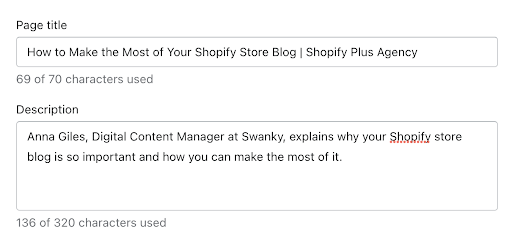
The SEO fields for your Shopify store blog include a field for the page title and one for the meta description.
In some instances, Google may display the text you enter in the SEO field, while other times it might show other relevant information from headings like H2s and H3s. It’s beneficial to optimize your meta description to boost click-through rates. The more people click on your result, the higher the likelihood that Google will improve your ranking in search results.
Meta descriptions should ideally be in the range of 120 to 155 characters, allowing a bit of flexibility. Google typically cuts off descriptions at around 155-160 characters, so it’s best not to exceed this limit to ensure proper display.
Take a look at the Yoast blog for insights on effective practices for meta descriptions.
4) Building Links
By creating internal links to various pages within your site, you can enhance the time readers spend on your site and increase page views. Link building, particularly to product and category pages, aids Google in indexing your articles and recognizing the interconnection between your pages.
A general recommendation is to include three to four links to other pages for every 1000 words. This translates to three to four links per blog post, assuming an average article length of 800-1500 words.
5) Calls to Action (CTAs)
CTAs strategically placed within a blog post serve to direct readers to take the next step. They play a significant role in generating leads on your website. From slide-in or sidebar CTAs to blog subscription prompts at the end of posts, there are various ways to incorporate them into your blog.
You can also foster social media engagement by inviting individuals to follow your company on their preferred platform. Occasionally, you may want to offer something that unlocks a discount or provides an incentive for an initial purchase or trial. Integrating CTAs in your Shopify blog facilitates the transformation of readers into customers.
Explore our comprehensive guide on creating impactful CTAs, filled with advice on achieving an ideal design and crafting compelling copy.
6) Enhanced Headings
Engaging, keyword-optimized headings are crucial for SERP rankings and aiding readers in navigating through an article. Let’s admit it, many of us prefer to skim lengthy articles to locate the information we are truly interested in.
Strike a balance between captivating, attention-grabbing titles and keyword-optimized, concise headings. It is advisable for your Shopify store blog content to feature H2, H3, H4, and occasionally H5 headings.
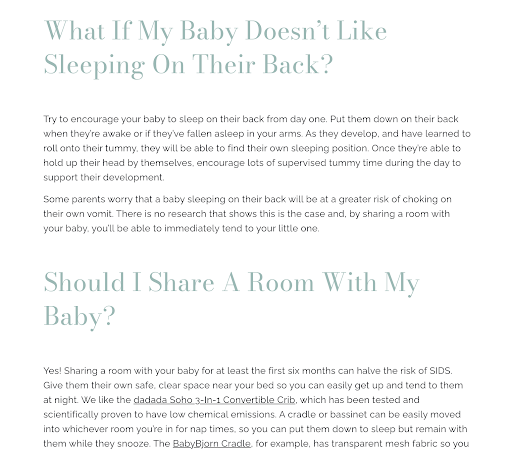
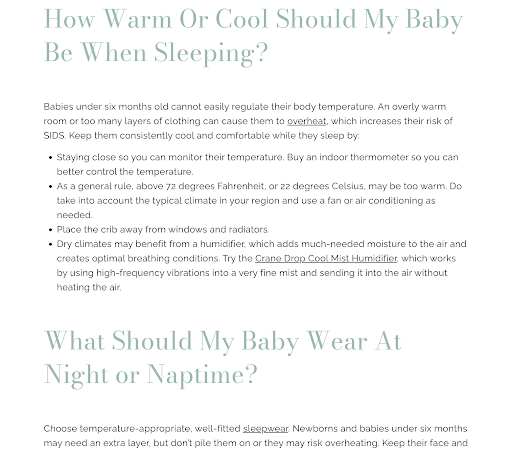
These keyword-enhanced headings help guide users through the blog article, aiding them in swiftly identifying the most relevant sections.
7) Word Count, Sentences, and Paragraphs
Aim for a blog post word count of 1500-1700 on your Shopify site. For improved readability, keep your sentences concise and ensure your paragraphs are not excessively lengthy. Lengthy blocks of text are discouraging and challenging to read. According to Yoast SEO – an SEO plugin now accessible for Shopify blogs – your sentences should ideally not exceed 20 words.
If you consistently construct sentences exceeding 20 words, you risk receiving a low readability score, which can impact your SEO negatively. Shorter sentences are more reader-friendly, engaging, and effective in conveying your message.
8) Visual Elements
Humans primarily comprehend information visually, and with a Shopify blog, adding images and embedding videos is effortless. Remember to include alt tags for images as this not only boosts your SEO score but also ensures accessibility for those with visual impairments.
9) Categorization and Tagging
Organizing your content is a valuable strategy to enhance user experience on your blog. Shopify enables you to create tags that aid in categorizing your blog posts by subject or into categories.
For instance, by using a tag for ‘pet care’ and applying it to posts related to pet care, you allow readers to click on the tag and discover other posts on the same theme. Additionally, when a customer searches for a tag on your online store, they will encounter relevant blog posts in the search results. Ensure your tags are concise with just one or two words to prevent overly long tag URLs.
Key Point: Prioritize Your Shopify Store Blog
For ecommerce marketers, implementing a data-driven blogging strategy should be a primary focus. Apart from enhancing organic search visibility, it establishes brand authority and fortifies customer relationships.
Utilize the tips shared in this article to maximize the potential of your Shopify blog and create informative, authoritative, and engaging content that both customers and search engines will appreciate.
Ecommerce Content Marketing Experts
Our proficient in-house content team comprises skilled copywriters, technical SEO specialists, and visual designers. Together, they will revitalize your ecommerce content marketing strategy by producing captivating, optimized articles for your Shopify store blog.
Reach out to our amiable team of Shopify Plus Professionals to explore how we can unleash your ecommerce potential.
